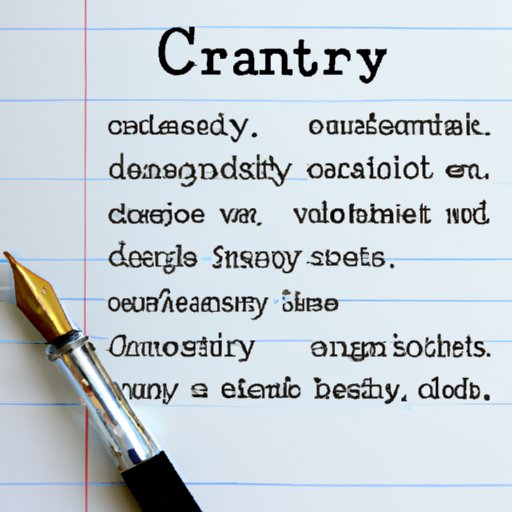Introduction
Writing with clarity is an essential skill for anyone who wants to communicate effectively and make a lasting impression. Clarity in writing is the ability to convey a message in a way that is easy to understand and free from confusion. It involves using language that is precise and unambiguous, so that the reader can easily follow the writer’s train of thought.
The benefits of clear communication are numerous. Not only does it help to ensure that the intended message is received, but it can also help to build relationships and trust between the writer and the reader. By writing with clarity, the writer can ensure that their message is understood and appreciated.
Crafting Clear and Concise Content
When crafting content, there are several tips that can help to make sure it is clear and concise. These include using plain language, focusing on one idea per sentence, cutting out unnecessary details, and keeping sentences short and sweet.
Use Plain Language
Using plain language is one of the most important steps to take when writing with clarity. Plain language is simple and straightforward, and avoids using overly complex words or phrases. This allows the reader to quickly and easily understand the message without having to decipher unfamiliar terminology.
Focus on One Idea Per Sentence
When writing, it is important to focus on one idea per sentence. This helps to avoid confusion by ensuring that each sentence has a single purpose. It also makes it easier for the reader to follow the writer’s line of thought, as each sentence builds upon the one before it.
Cut Out Unnecessary Details
In order to keep the text concise and clear, it is important to cut out any unnecessary details. This includes removing any extraneous information that does not contribute to the overall message. Doing this will help to make sure that the reader does not get lost in the details and can stay focused on the main point.
Keep Sentences Short and Sweet
It is also important to keep sentences short and sweet. Long, drawn-out sentences can be difficult to follow and can lead to confusion. By keeping sentences concise, the writer can ensure that their message is communicated clearly and efficiently.

Strategies to Improve Clarity in Writing
There are also several strategies that can be used to improve clarity in writing. These include avoiding confusing the reader, choosing the right words, avoiding jargon and buzzwords, and explaining unfamiliar concepts.
How to Avoid Confusing Your Readers
One of the best ways to avoid confusing the reader is to use active voice. Active voice makes it clear who or what is doing the action in each sentence, which can help to reduce confusion. It is also important to choose the right words, as some words may have multiple meanings and could cause confusion if used incorrectly.
Avoid Jargon and Buzzwords
It is also important to avoid using jargon and buzzwords when writing. Jargon and buzzwords can be difficult to understand, and can often make the text harder to read. Instead, it is better to use more familiar words that everyone can easily comprehend.
Explain Unfamiliar Concepts
Finally, it is important to explain unfamiliar concepts. If the reader does not understand a particular concept, it is better to explain it rather than leaving them confused. This will help to ensure that the reader is able to understand the text and get the most out of it.
Writing with Precision
Writing with precision is another key element of clarity in writing. There are several techniques that can be used to communicate with clarity, including using examples and analogies, utilizing visual aids, breaking up long blocks of text, and reading work aloud.
Use Examples and Analogies
Using examples and analogies can be a great way to illustrate a point or concept. Examples provide concrete illustrations that can help the reader to understand the concept more easily. Analogies can also be used to compare two similar concepts and help the reader to gain a better understanding.
Utilize Visual Aids
Another useful technique is to utilize visual aids such as diagrams, charts, and graphs. These can help to make complex concepts easier to comprehend and can help to break up long blocks of text. They can also be used to highlight important points and give the reader an overall picture of the text.
Break Up Long Blocks of Text
Long blocks of text can be difficult to read and can lead to confusion. To avoid this, it is important to break up the text into smaller chunks. This can be done by adding headings, subheadings, bullet points, and other visual elements to make the text easier to digest.
Read Your Work Aloud
Finally, it is always a good idea to read your work aloud. This can help to identify any awkward phrasing or unclear sentences. It can also help to catch any typos or grammatical errors that may have been missed during the editing process.
Developing a Style of Clarity
Developing a style of clarity is an art form. It involves establishing and maintaining a consistent tone, making sure that the point is clear, incorporating transitions between ideas, and ensuring that all information is accurate and relevant.
Establish and Maintain a Consistent Tone
When writing, it is important to establish and maintain a consistent tone. The tone should be appropriate for the audience and topic at hand. It should also reflect the writer’s personality and values, and should remain consistent throughout the entire piece.
Make Sure Your Point Is Clear
It is also important to make sure that the point of the text is clear. This means that the main idea should be clearly stated and supported with evidence. Any supporting points should also be clearly explained and linked back to the main point.
Incorporate Transitions Between Ideas
In order to make the text flow smoothly, it is important to incorporate transitions between ideas. Transitions help to connect different ideas together and create a logical structure for the text. This makes it easier for the reader to follow the writer’s line of thinking and understand the overall message.
Ensure That All Information Is Accurate and Relevant
Finally, it is important to make sure that all information is accurate and relevant. This means double-checking facts and sources, and making sure that the information is up to date. It also means ensuring that all information is relevant to the main point of the text and does not deviate from the main topic.

Creating Clarity in Your Writing
When creating clarity in writing, it is important to keep the message simple and to pay attention to punctuation. It is also important to revise and edit the work to eliminate any errors or inconsistencies. Finally, it is essential to know the audience and tailor the writing to their needs.
Know Your Audience
Knowing the audience is essential when writing with clarity. Different audiences may have different levels of knowledge and understanding, so it is important to tailor the writing accordingly. This will help to ensure that the message is understood and appreciated by the reader.
Keep Your Writing Simple
It is also important to keep the writing simple. This means avoiding overly complex words and phrases, and using language that is easy to understand. It also means avoiding long, drawn-out sentences and making sure that the main point is clearly stated.
Pay Attention to Punctuation
Punctuation is also important when writing with clarity. It helps to separate ideas and make the text easier to read. It is also important to use correct grammar and spelling, as these can affect the clarity of the text.
Revise and Edit Your Work
Finally, it is important to revise and edit the work. This helps to identify any mistakes or inconsistencies and make sure that the text is clear and concise. It is also a good idea to read the text aloud to check for any awkward phrasing or unclear sentences.

Establishing Clarity in Your Writing
Establishing clarity in your writing also involves examining the role of grammar, syntax, and structure. Utilizing grammatical rules, understanding syntax structures, and following a logical organization can help to ensure that the text is clear and easy to understand.
Utilize Grammatical Rules
It is important to utilize grammatical rules when writing. Grammar can help to make the text more precise and clear, as incorrect grammar can lead to confusion. It is also important to make sure that the verb tense and subject-verb agreement are correct.
Understand Syntax Structures
Understanding syntax structures is also essential for clarity in writing. Syntax refers to the way in which words and phrases are arranged. Understanding the various syntax structures can help to make sure that the text is structured correctly and flows smoothly.
Follow a Logical Organization
Finally, it is important to follow a logical organization when writing. This means organizing the text in a way that makes sense and is easy to follow. It also means making sure that the text is properly structured and that the main point is clearly stated.
Conclusion
In conclusion, clarity in writing is an essential skill for anyone who wants to communicate effectively and make a lasting impression. It involves using language that is precise and unambiguous, so that the reader can easily follow the writer’s train of thought. Crafting clear and concise content involves using plain language, focusing on one idea per sentence, cutting out unnecessary details, and keeping sentences short and sweet. Strategies to improve clarity in writing include using active voice, choosing the right words, avoiding jargon and buzzwords, and explaining unfamiliar concepts. Writing with precision involves using examples and analogies, utilizing visual aids, breaking up long blocks of text, and reading work aloud. Establishing clarity in writing involves utilizing grammatical rules, understanding syntax structures, and following a logical organization. By writing with clarity, the writer can ensure that their message is understood and appreciated.
(Note: Is this article not meeting your expectations? Do you have knowledge or insights to share? Unlock new opportunities and expand your reach by joining our authors team. Click Registration to join us and share your expertise with our readers.)
